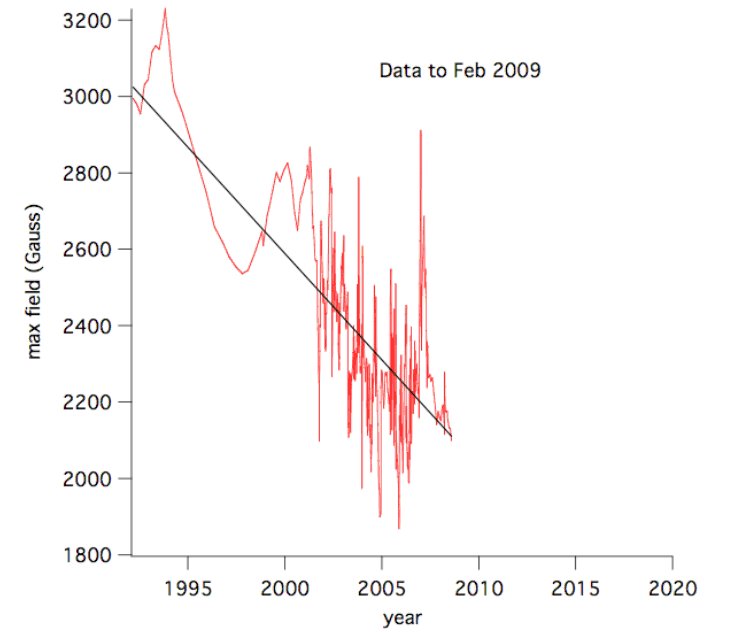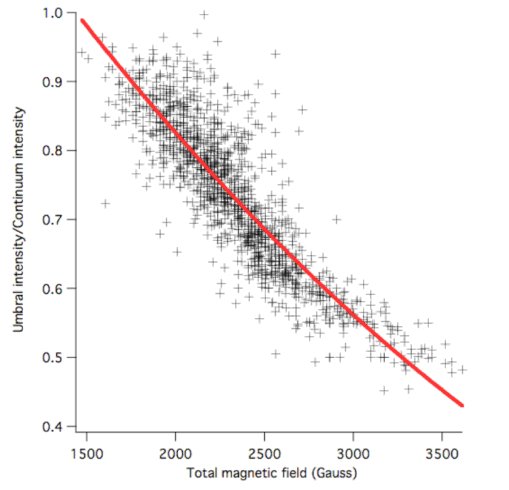I received this email from Dr. Richard Mackey of Australia, a solar statistician expert and peer-reviewed author on solar climate factors. I thought you might find his comments and insight interesting. In it he discusses the extreme scenario that the current solar cycle, the longest in at least 150 years and with more sunspotless days (689 days as of today - more than double the number in the cycles the last half century) during this transition could be telegraphing.
Astronomer Emeritus Dr. William Livingston and Associate Astronomer Dr Matthew Penn have for many years been measuring the magnetic field strength of the Sun's magnetic fields. See for example this post. WUWT in June this year published a report by them concluding that, broadly speaking, over the last 15 years the magnetic field strengths of sunspots were decreasing with time independently of the sunspot cycle. A simple linear extrapolation of the magnetic data collected by their special observatory (the McMath-Pierce telescope) suggests that sunspots might largely vanish in five years time. In addition, other scientists report that the solar wind (a large proportion of the Sun's output of matter in the plasma form) is in a lower energy state than found since space measurements began nearly 40 years ago.
In answer to the question: Why is a lack of sunspot activity interesting?, Livingston and Penn answer: "During a period from 1645 to 1715 the Sun entered an extended period of low activity known as the Maunder Minimum. For a time equivalent to several sunspot cycles the Sun displayed few sunspots. Models of the Sun's irradiance suggest that the solar energy input to the Earth decreased during that epoch, and that this lull in solar activity may explain the low temperatures recorded in Europe during the Little Ice Age".
EOS is the professional publication of the American Geophysical Union. It is a broadsheet sent every week to AGU members. It always has one feature article, but mainly lists job advertisements and notices about conferences, seminars and the like of interest to AGU members and news of members' achievements. The feature articles are sometimes about climate change, which are generally supportive of the IPCC dogma.
In EOS of 28 July 2009 there is a very well written feature length article by Livingston and Penn entitled "Are Sunspots Different During This Sunspot Minimum?" Livingston and Penn answer yes. Their central finding is that regardless of the relation to the sunspot cycles, magnetic intensity in sunspots is decreasing and if this continues in the same way as it has for the last 15 years, the Sun will be devoid of sunspots in five years time: overall the Sun's energetic output will decline significantly inducing another little ice age on the Earth.
Livingston and Penn conclude their EOS article with these comments: "Whether this [decline] is an omen of long-term sunspot decline, analogous to the Maunder Minimum, remains to be seen. Other indications of the solar activity cycle suggest that sunspots must return in earnest next year. Because other indications point to the Sun experiencing an unusual period of minimum solar activity, it is critically important to measure the Sun's magnetic activity during this unique time."
Another interesting aspect of Livingston and Penn's EOS article is that the AGU published it in its professional publication. This suggests to me that the professional societies are returning to practice of true scientific debate that has been suppressed for so long. It is worth recalling the feature article "Natural antidote to global warming" written by Sir John Maddox, then the editor of Nature and published in Nature on 21 September 1995. Sir John referred to the extensive research published up to 1995 indicating the Sun-climate relationship and that the Sun was likely to enter into a Maunder Minimum inducing state sometime during the first few decades of the new millennium.
Sir John, an enthusiastic apostle of the IPCC dogma, asked: "There remains the question of whether the Maunder Minimum will arrive in time to avoid a global carbon tax?" He answered that on the basis of his reading of the evidence published up till then there was only a small chance. However, he concluded by noting that it is a real possibility and that the moral of his commentary was "a better understanding of the Sun might now have practical value."
Livingston and Penn and a large number of solar physicists (see, for example, the home page of the grandfather of modern solar physics, Professor Emeritus Cornelius de Jager, here would say that now the likelihood of the Earth being seized by Maunder Minimum is now greater that the Earth being seized by a period of global warming. They would answer Sir John's question by saying: "Yes, the Maunder Minimum will arrive in time to save the planet from the utterly foolish global carbon tax".
Richard Mackey:
Indeed the next few years will be of great interest to see what happens with the sun and if it is indeed a dud few cycles, the climate. Will it refute the IPCC claims that the sun is not an important climate driver in modern times. Read full email and post here. It is my belief we are heading towards a Dalton like minimum based on the behavior of the last four cycles and their similarity to cycles 1-4 in the late 1700s. But the longer the sun stays quiet (today is the 37 straight sunspotless day and we have had 690 sunspotless days this transition already), the more one wonders. 2009 will make a run at the top 5 sunspotless years since 1849 and at 2008 with its 265 spotless days with 179 already this year with four and one half months to go.





Reader Comments
to our Newsletter